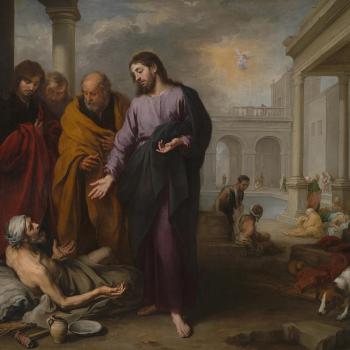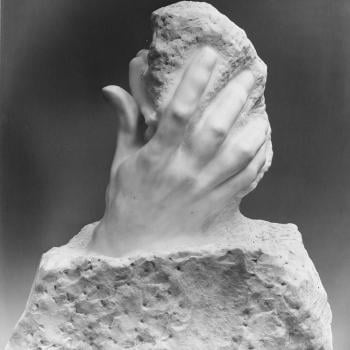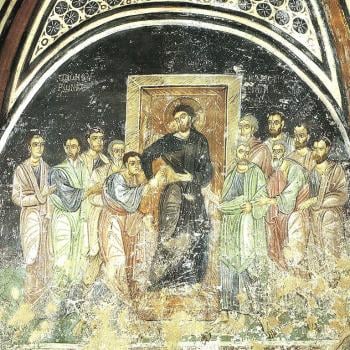Scripture tells us that whenever king Saul suffered malaise from an evil spirit, his successor, prophet-king David would play the lyre, and through his music, David would restore peace of mind and soul to Saul:
And whenever the evil spirit from God was upon Saul, David took the lyre and played it with his hand; so Saul was refreshed, and was well, and the evil spirit departed from him (1 Sam. 16:23 RSV).
What might seem strange to most readers is the indication that the evil spirit is said to be from God. Why would God, who is a God of love, send out an evil spirit so as to cause someone trouble? Does God do what is evil? Certainly not.
Instead, it is as St. Anthony of Padua explained. The spirit is from God because it was created by God. In its creation, the spirit was good, but through its will, the spirit changed and became an evil spirit, not a spirit which was purely evil (for nothing which exists is pure evil), but a spirit who is said to be evil because of its evil actions:
The evil spirit from the Lord is the devil. He is ‘from the Lord’, because he was created by Him; he is evil because of his own malice. He was changed from light-bearer to dark-bearer, from angel to devil. That is why he is called ‘devil,’ the ‘outcast.’[1]
Saul, however, is more than the king of Israel, he is in Scripture a representative of all abusive sinners, all who in their search for self-satisfaction use power to lord it over all who would get in their way:
He seizes Saul (whose name means ‘abuser’), the sinner whom, as Job says,
God has given [him] place for penance; and he abuseth it unto pride, [Job 24.23]
when he draws him from sin to sin.[2]
When we give ourselves over to sin, and allow sin to transform us into abusers of others, we find ourselves represented by Saul. Since sin is the opposite of love, the more we embrace it, the more we become destructive we become, not only with others, but with ourselves. Sin will affect our mind, allowing the darkness of its destructive force come in contact with and engage the other dark forces which sin represents, so that one sin will lead us to more sin, until at last, if we do not stop ourselves, we will be engaging and following all the sins together. We will create our own darkness within, giving room for whatever dark powers that be to take that darkness within and use it to cause our own pain and suffering. As we lord it over people through our sin, we open ourselves to be lorded over by the higher powers and their evil might.
What, then, of David? How does he soothe Saul? Anthony tells us it was as a preacher, as one who brought Saul back to reality and repent, time and time again, allowing the grace of the Lord to work through him and bring Saul back to a semblance of spiritual integrity:
But David (that is to say, the preacher), must take his hard, the most sweet music of his preaching, and strike it with the hand of his operation. [3]
The point of the story is more than to tell what happened to Saul, but to see how the Lord, the true musician of the soul, represented by David, is able to preach to all, and turn sinners away from their sin, curing them from the maladies which they establish in their lives thanks to their sin:
In this way the sweetness of the harp, the power of the Lord’s preaching, will lessen the sinner’s fever and drive the devil from him.[4]
David, the prophet-king friend of God prefigured the messianic legacy of Jesus, the true and eternal priest, prophet and king. David was able to bring peace to Saul, albeit in a temporary fashion, while Jesus, as the great harmonizer, is able to bring true and eternal peace to our souls. “Peace I leave with you; my peace I give to you; not as the world gives do I give to you. Let not your hearts be troubled, neither let them be afraid” (Jn. 14:27 RSV).
![Christ as Orpheus from the Catacombs [Public domain], via Wikimedia Commons](https://wp-media.patheos.com/blogs/sites/637/2016/12/Christ-Orpheus_from_Rome_catacombe-300x233.jpg)
Another symbolic representation of Christ is borrowed from ancient mythology: the rather infrequent representation of Christ as Orpheus, with a lyre in His hand and surrounded by animals. This symbol is frequently found in the writings of Christian antiquity, starting with Clement of Alexandria. Just as Orpheus subdued the wild beasts with his lyre and charmed the mountains and trees, so did Christ attract men with His divine word and subdue forces of nature. [5]
This is not to say there was no critical aspect to this adaptation of pagan symbols and traditions; even St. Clement of Alexandria, while borrowing from the myth of Orpheus, saw it was important to contrast the reality of Christ to the legends of Orpheus, showing how superior Jesus was to the imagery employed by the Orphic myths. Clement wanted to make sure his readers did not take uncritically erroneous elements from the Orphic Mysteries, and yet, with all that said and done, it was easy to see how Orpheus and his legends could point to the work established by Jesus. Christ subdued the animals inside us, the evil thoughts and desires which animals in the Orphic myths can be seen to represent. But because Christ was the God-man, Clement, while recognizing and respecting the truths found in the pagan traditions, pointed to their limits, so Christians would not find themselves constrained to the myths of old but could be opened up and receive the greater revelation found in Jesus Christ:
And the Spirit says by Isaiah the prophet, “I will give you treasures, hidden, dark.” Now wisdom, hard to hunt, is the treasures of God and unfailing riches. But those, taught in theology by those prophets, the poets, philosophize much by way of a hidden sense. I mean Orpheus, Linus, Musæus, Homer, and Hesiod, and those in this fashion wise. The persuasive style of poetry is for them a veil for the many.[6]
This is how and why Christians could look to the pagan myths and traditions and find much profit in such humanistic activity. Though such traditions were limited in what they offered, they still proclaimed truths which pointed to Christ and could be recognized and respected when such truths were proclaimed. For this to be done properly, Christ had to become the lens by which the ancient pagan myths were read and interpreted. Christians transformed the meaning of such ancient myths, but they did so in the way they did with the Torah: all pre-Christian traditions with their symbols were able to be used by Christians once a way was found to discern Christ in them, giving them, as Ouspensky said, a new meaning:
The early Christians primarily used biblical symbols – the lamb, the ark, etc. But once pagans began entering the Church, these symbols were no longer sufficient since pagans frequently did not understand them. And so the Church adopted some pagan symbols capable of conveying certain aspects of its teaching. The Church gave these symbols a new meaning, purifying them so that they would recapture their primitive meaning. They were used to express the salvation accomplished in the Incarnation.[7]
Eusebius, following Clement, therefore gives us a great representation of the relationship between Orpheus and Christ, once again showing how and why iconography of Christ could and did merge with iconography of Orpheus:
Thus, I say, did our common Saviour prove himself the benefactor and preserver of all, displaying his wisdom through the instrumentality of his human nature, even as a musician uses the lyre to evince his skill. The Grecian myth tells us that Orpheus had power to charm ferocious beasts, and tame their savage spirit, by striking the chords of his instrument with a master hand: and this story is celebrated by the Greeks, and generally believed, that an unconscious instrument could subdue the untamed brute, and draw the trees from their places, in obedience to its melodious power. But he who is the author of perfect harmony, the all-wise Word of God, desiring to apply every remedy to the manifold diseases of the souls of men, employed that human nature which is the workmanship of his own wisdom, as an instrument by the melodious strains of which he soothed, not indeed the brute creation, but savages endued with reason; healing each furious temper, each fierce and angry passion of the soul, both in civilized and barbarous nations, by the remedial power of his Divine doctrine. Like a physician of perfect skill, he met the diseases of their souls who sought for God in nature and in bodies, by a fitting and kindred remedy, and showed them God in human form.[8]
This, once again, brings us back to David and how he prefigured Christ in his pacification of Saul. Music is able to tame the beast, the beast which is within all of us, the beast which is the power of the flesh and its desires. The beast is good, as all of God’s creation is good, but sin has unleashed it before it has become tame, so now it needs the harmony of God’s grace to pacify it and render it obedient to the spirit. David and Orpheus together, in the Jewish and pagan traditions, represent what Christ is to do for our souls.
For this reason, let us now listen to the new song of salvation and let Christ pacify us, so that we can truly follow after him, the Prince of Peace, and sing with him in the harmony with God’s eternal choir: “O come, let us sing to the LORD; let us make a joyful noise to the rock of our salvation! Let us come into his presence with thanksgiving; let us make a joyful noise to him with songs of praise! For the LORD is a great God, and a great King above all gods” (Ps. 95:1-3 RSV).
[1] St. Anthony of Padua, “Third Sunday of Lent” in Sermons for Sundays and Festivals. Volume I. trans. Paul Spilsbury (Padova: Edizioni Messaggero Padova, 2007). 139.
[2] Ibid., 139.
[3] Ibid., 139.
[4] Ibid., 139.
[5] Leonid Ouspensky, Theology of the Icon. Volume One. trans. Anthony Gythiel and Elizabeth Meyendorff (Crestwood, NY: St Vladimir’s Seminary Press. 1992), 69.
[6] St. Clement of Alexandria, Stromata in ANF(2):449-50.
[7] Leonid Ouspensky, Theology of the Icon. Volume One. trans. Anthony Gythiel and Elizabeth Meyendorff (Crestwood, NY: St Vladimir’s Seminary Press. 1992), 67.
[8] Eusebius, “Oration in Praise of Constantine” in NPNF2(1):603.
Stay in touch! Like A Little Bit of Nothing on Facebook:
A Little Bit of Nothing













